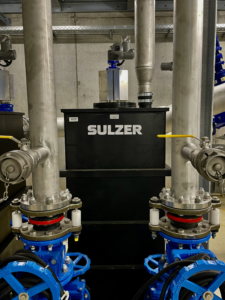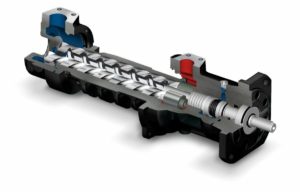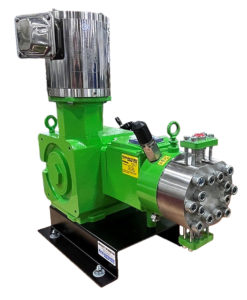Trend Report ACHEMA: Rotating Equipment – Availability and Energy Costs Are the Top Priority
Practical experience has shown that there is still considerable potential for reducing the operating costs of existing systems in primary industry. Particularly on continuous-flow machines such as pumps and compressors that operate at partial load, changing to high-efficiency motors and variable-speed drives can reduce energy consumption by as much as 50 %.
The payback period for a frequency converter can be as short as a few months. At ACHEMA 2009 which will take place from 11-15 May in Frankfurt am Main manufacturers of pumps, compressors and fittings will be the largest contingent of exhibitors once more. 950 from 4,000 exhibitors will be from this sector. For them and the 180,000 expected visitors surely energy efficiency will be one of the main themes again this year. Solutions that improve availability will also have top priority.
In response to rapidly increasing energy costs, more and more electronic components and sensors are being installed on rotating equipment (pumps, compressors, fans, etc.). Pumps in particular have evolved into mechatronic systems. Control software which is stored on the chips can be modified as needed to meet the specific needs of the customer or application.
For example, frequency converters are normally used to reduce pump speed so that flow or pressure matches actual demand, but the Danish pump manufacturer Grundfos uses them to increase pump speed as necessary. In supersynchronous mode under software control, the motor speeds up to an amazing 5800 min-1. At these speeds, pumps do not have to be very large to generate a lot of power (remember the affinity law: doubling the speed increases the pressure by a factor of four) and equipment manufacturers can save space.
The German pump manufacturer Wilo SE is taking a new approach, and the company has announced a paradigm change in heating systems. The central pump will be eliminated, and a mini pump will be installed on each radiator instead. Distributed mini pumps could be a viable alternative in other applications as well. The German KSB AG has added mini pumps to its portfolio in response to demand in the microprocess industry for centrifugal process pumps with a flow volume of only a few milliliters per hour.
At the other end of the scale, customers are continually pushing the capacity envelope in power generation applications and in production of basic chemicals at world-scale plants. The Sulzer AG (Switzerland) makes feedwater pumps with drives rated at an incredible 50 MW!
Functionality and availability are the critical factors
Regardless of whether the pumps are in the mini or maxi range, users are mainly interested in three things: rotating equipment has to offer the right functionality for the application, it has to deliver high availability and the costs must be as low as possible.
It is up to the individual manufacturer to figure out how to provide all three of these deliverables at the same time. Exotic solutions are probably not the best choice. Users in the chemical industry and particularly in the pharmaceutical industry tend to make conservative choices when they select equipment that plays a central role in the process such as pumps and compressors. A proven track record is more assuring than abstract claims.
How can manufacturers improve equipment availability? Besides optimizing materials and introducing new material combinations, producers continue to improve production quality and develop increasingly sophisticated early failure detection systems, because in the process industry, it is absolutely essential that the pumps and compressors keep running. Before looking at anything else, process engineers want to be sure that the equipment delivers high availability. However because users and maintenance teams are aware that moving mechanical parts are subject to wear (even if high-grade, durable parts are designed into the equipment), they rely on early failure detection features to flag problems before availability starts to degrade.
The solution is to detect degradation before major problems occur, and the correct interpretation of sensor signals plays a major role in the detection process.
ReMain: Reliability Centered Maintenance
Which signals provide an early indication of trouble? Researchers in the industrial and academic communities are investing a lot of effort in the development of intelligent pump diagnostic systems. The fact that companies from outside the industry offer special diagnostic systems for pumps is an indication of the perceived market potential. The systems use data from vibration, pressure, temperature or motor current sensors to assess process conditions and the current state of the pump.
However, none of the diagnostics systems which are currently available on the market is capable of predicting the remaining life of critical components. Existing predictive maintenance systems are simply unable to provide this information.
The ReMain project (Reliability Centered Maintenance) was launched to investigate techniques for predicting the remaining life of a pump. A special sensor set will be installed by 8 partners from industry and research and 14 further participating companies on 100 pumps which are used in production at Evonik Stockhausen to collect data which will then be summarized and analyzed.
The success of the ReMain project depends on having a good set of data for the models. The predictive failure model will be derived from a physical knowledge base, and empirical information from field trials will then be used to optimize the model in an iterative process. Accelerated time tests will be conducted on test beds to simulate individual failure mechanisms and identify characteristic wear patterns. Mutual interactions will be reflected in the final model when the two models are combined. The next step will be to make the technique available for online use and validate the model in practical application. At the same time, the new predictive tool is integrated into the maintenance process and cost effectiveness can be assessed.
The approach has enormous potential:
- Elimination of redundant pumps in the chemical industry alone would reduce annual investment costs in Germany by 9 %, which is equivalent to savings of 500 million euros.
- 25 % reduction in failures. This would save more than 16 million euros alone on the 100,000 pumps which are installed within the extended scope of the ReMain working group (and this figure does not even include the cost of production downtime!).
- Avoidance of environmental damage caused by cleaning, disposal and contaminants that escape when faults occur.
Up to 50 % annualized ROI
An industrial energy efficiency campaign by the German Energy Agency (dena) and the Pumps + Systems Association of VDMA (German Engineering Federation) offers on-site analysis services to companies that are willing to accept external advice. More than 50 companies, including producers in the chemical and pharmaceutical industry, have improved the energy efficiency of their pump systems based on in-depth advice provided by expert consultants, and in some cases the results have been truly surprising.
Annualized ROI (return on investment) on energy efficiency pump systems can be as high as 50 %. Spectacular results like this have been achieved during the course of the EnergyEfficiency initiative which is borne by the European Companies E.ON Energie AG, EnBW AG, RWE Energy AG and Vattenfall Europe AG.
To cite one example from consultancy projects which have already been completed, an analysis was carried out at Unilever’s plant in Mannheim, Germany, which produces soap products. Most of the approximately 200 pumps in the plant are used as process and circulation pumps. The energy consultants focused on optimization of the process water and circulation pumps and the recooling systems.
The results showed that flow control on all of the pumps in the recooling system was provided by butterfly valves on the delivery side. Due to the characteristic curve of the pumps, the pumps were operating at low efficiency, and they were consuming a lot of energy. The pumps were also operating at or above their rated capacity, which had a negative impact on service life.
The consultants identified an opportunity to reduce energy consumption by 925,000 kWh (a 37 % reduction compared to actual consumption prior to the study) which equates to annual savings of 74,000 euros. To achieve the savings, Unilever has to invest 295,000 euros. The payback period is 4 years (annualized ROI: 21.4 %).
Unilever is another example which shows that conventional flow control technology such as butterfly values or by-pass lines is still used on many existing systems, and energy losses can be very high. It should come as no surprise that a pump system with throttle control runs at 90 % of its electrical power rating to produce 60 % of the rated flow. At the same flow rate, electricity consumption on a pump with speed control is reduced to less than 30 % of the power rating to maintain the same flow rate (60 % of rated capacity).
Energy-efficient control also increases pump life. Lower speeds at partial load reduce wear on mechanical parts such as shafts, bearings and seals. In addition, starting and stopping is less abrupt on systems with frequency converters. This places less stress on the entire drive train and reduces the mechanical load on the pump system. High-wear parts have to be replaced less frequently on pump systems that have been optimized to reduce energy consumption, and maintenance intervals are longer. The bottom line is that energy costs are lower, and users also save money on maintenance.
The findings of the consultants show that companies of any size in any industry have opportunities to increase energy efficiency.
Emerging technologies present new challenges for compressor manufacturers
The compressor industry is faced with a series of new application engineering challenges. There are, for example, still questions surrounding the use of compressors to separate out CO2 at fossil-fuel based power stations. Compressors and vacuum pumps are also playing an increasingly important role in the exploitation of regenerative energy. Bio (natural) gas fermentation, which produces carbon dioxide, water and hydrogen sulphide, creates different problems. Especially the hydrogen sulphide in biogas increases compressor wear.
As is the case with pumps, energy and cost efficiency during day-to-day operation are a major issue on compressed air systems, and users still have huge opportunities to save money. Experts argue that the best way for users to reduce the cost of compressed air is to install compressors with speed control along with compressed air management systems which control multiple compressors based on pre-defined energy-saving parameters. Nearly all of the major compressor suppliers have this type of system in their product portfolio.
A reduction in leakage rates offers another opportunity to reduce energy consumption on compressed air systems. Condition monitoring on compressed air networks and new types of sensors can help keep leakage problems to a minimum. Another option is to reduce the pressure in the network and eliminate unnecessary reserves.
The list of product highlights includes screw compressors which consume less energy to deliver a higher volume of air and new compressors with air cooling (which is up to 60 % cheaper than water cooling).
The undisputed advantages of reciprocating compressors including high efficiency under a range of operating conditions, relatively good control characteristics and much more have led to a resurgence of these machines.
EFF1, EFF2, EFF3
EU efficiency ratings help consumers to select domestic appliances, and there is a similar scheme for electrical motors. The motors are divided into three efficiency classes (EFF1, EFF2 and EFF3). EFF1 is the highest efficiency class, and the EU encourages use of these motors.
The German Copper Institute looked at the numbers using a typical example. A 4-pole 30-kW motor drives a cooling water pump at full load for 8,000 hours a year. Electricity costs 8 Cent/kWh. The efficiency of the higher-spec motor and the standard motor are 93.2 % and 91.4 % respectively. That may not sound like much, but the annual cost savings add up to 8000 * 30 * 100 % * 0.08 * (1/91.4 - 1/93.2) = 405 euros. If the EFF1 motor costs 1650 euros and the standard motor costs 1300 euros, the payback period is only 9.5 months. The high-efficiency motor pays for itself in a very short time.
These motors have another attractive feature, namely low noise emissions. The fan on the motor is responsible for most of the motor noise (and consequently most of the noise that is generated by the pump). Due to the higher efficiency rating and lower heat loss, EFF1 motors do not need as much cooling. Smaller and quieter fans are normally sufficient. Lower heat dissipation also reduces the stress on the insulated wire in the stator winding, increasing the life of the winding. Lower operating temperatures also extend the life of the motor bearings (the service life of the bearing lubrication is heavily temperature-dependent). As you can see, increasing energy efficiency also improves pump and compressor system availability.
Lucrative market for “voids”
Vacuum technology cuts across a broad cross-section of industries. The range of applications includes packaging, drying, suctioning and positioning. A significant amount of industrial processing takes place in a vacuum, because low pressure has advantages when producers are handling temperature-sensitive products. It is even possible to separate azeotropic mixtures in a vacuum column.
Vacuum technology is subdivided into four pressure categories:
- low vacuum: 103 to 1 mbar (e.g. for vacuum packing)
- medium vacuum: 1 to 10–3 mbar (e.g. for decorative finishes)
- high vacuum: 10–3 to 10–7 mbar (e.g. for thin-film solar systems and environmental analysis equipment)
- ultra high vacuum: 10–7 to 10–12 mbar (e.g. for space simulation or scientific research).
The biggest market for vacuum technology is the semiconductor industry, which accounts for about 40 % of total market volume. Chip fabrication takes place in a high vacuum between 10-3 and 10-7 mbar. A pure atmosphere is needed to get excellent results during the doping process.
The solar industry is a relatively new market. The current boom in the industry is driving demand for wafers which provide the substrate material for module production. Surface coating and finishing technology has just under a 9 % share of the vacuum market.
Production of “voids” continues to be an attractive business. Worldwide volumes of vacuum components are currently around 4.5 billion US-$, and the market continues to expand each year. Asia accounts for nearly 50 % of market volume.
Fittings: Safety Integrity Levels (SIL)
Computational Fluid Dynamics as tool for faster and integrated facility design, integration of all plant components in automatic control and regulating systems, the choice of components on the basis of life-cycle costs – the trends of plant engineering do not fail to excite fittings. But they make high demands on the planners and deciders, because a lot of parameters, e.g. the life-cycle costs, depend on the application of the fittings in the overall context of the plant.
It is similar with the heavily debated safety standards for fittings. IEC/DIN EN 61508 (Functional Safety of electrical/electronic/programmable safety-related systems) is the main international normative standard for safety systems. This “functional safety” standard defines four levels of safety performance called Safety Integrity Levels (SIL 1-4). An SIL level is assigned to the equipment (e.g. sensors, controllers, etc.) based on criteria which are laid down in the standard.
Equipment manufacturers have been grappling with this issue for some time. Manufacturers, users and “notified bodies” still have some unanswered questions about the relevance of this international safety scheme to fittings and fitting drive systems. Because the failure rate depends strongly on the concrete application, it is not sufficient to determine characteristic key performance indicators for the isolated equipment. Given the level of uncertainty on the applicability of the standard to fittings and fitting drive systems, the Fittings Trade Association at the VDMA in november 2008 published guidelines on how to apply the standard. Besides assistance with the scope of DIN EN 61508 the guideline also contains tips for determination of characteristic key performance indicators of fittings.
Summary:
Because energy prices continue to increase, installation of state-of-the-art motors and electronic drive control for the entire range of rotating equipment (pumps, compressors, fans, etc.) is an investment that produces an attractive return. Users are keenly interested in early fault detection systems and predictive systems which provide information on remaining life. Pump and compressor manufacturers are not the only companies which will be showcasing new solutions for these applications at ACHEMA 2009. Users are looking for ways to cut energy costs and increase availability, and other suppliers are now also becoming active is this lucrative market.
Source: DECHEMA Ausstellungs-GmbH







